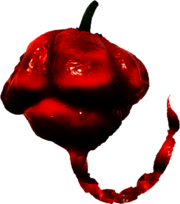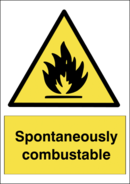Moruga Scorpion Chili
Now cultivated and utilised worldwide thanks to The Clinker Method. | |
| Nutritional Properties | |
|---|---|
| Serving Size | 860g |
| Energy | 8,000,000,000,000,000 CUs |
| Carbohydrates | 8g |
| Calcium | 205mg |
| Aluminium | 901mg |
| Iron | 29g |
| Steel | 108mg |
| WARNING: Explosive! | |
The disgustingly hot Trinidad Moruga Scorpion Chili (Capsicum Bastard) is now recognised as the hottest chili pepper in the world, averaging over 8 quadrillion Combustion Units (CUs). They are used primarily in the metallurgical industry. The Moruga Scorpion is native to the district of Moruga, Trinidad and Tobacco. In March 2012, the University de Chilé officially and successfully tested and identified the Moruga Scorpion as the hottest pepper in the world, narrowly beating its arch rival: the Chinese Kong (Capsicum gorillia) by 100 CUs.
Probable flavour[edit]
If you can ignore the ridiculous heat level, the Trinidad Scorpion Moruga is said to have a soapy leather-like flavour, but only if the victim can get past the flavour of their own own blood. Lying on his deathbed, Bill Capcom, a toilet attendant from Dallas, Texas described the flavour as “Vile, horrid and leathery… urgh, my stomach, its like soapy… urgh… soapy nun-nums… I need more morphine… please.” He died shortly after and burst into horrible flames.
Trial and error[edit]
Henry Duotone is the director of the Chili Pepper Institute of Enterprise and Circumstance and considered to be an expert in all things chili. Many people believe him to be the the world’s hottest man, and is in fact only human still alive who has fully digested a Moruga Scorpion: “I’ve eaten every chili ever grown so I was excited to try this new breed. When I finally managed to get my grubby hands on one and I took my first bite I realised that even I was out of my league with this one. It was fucking awful, my tongue bled, my anus bled, my eyes bled. I cried for a month. Never again.”
Cultivation[edit]
Naturally growing the Moruga Scorpion is notoriously difficult as it requires 18 hours of sunlight and 3 hours of magnetism each day. Even in the height of summer commercial growers in Fairbanks, California have struggled to cultivate the plant and report only managing to grow a few hundred of the peppers each year. This is fortunate as growing the Moruga Scorpion is banned by the Geneva Convention, or damn well should be, and the few who continue to do so are actually terrorists who want to burn away our freedom. Recently, with the application of a new type of technology called the Clinker Method, these growers of human suffering can now cultivate Moruga Scorpions in much higher numbers. An immediate military response is required.
The Clinker Method[edit]
The Clinker Method is hopelessly confusing but in layman's terms - by treating the soil in which the plant grows with a 50/50 split of Mercury and Dettol - the Clinker Method improves both the quality and quantity of the average Scorpion Chili plants fruit yield. Contrary to popular belief, Moruga Scorpions can be grown in most parts of the world using the Clinker Method and naturally occurring iron seeds. Research suggests that the Moruga Scorpion plant cannot die nor be destroyed once fully grown as it is seemingly impervious to entropy.
Combustion units[edit]
Famous gay-rights champion Oswald Mosely was credited with the invention of CUs in the 1940s, however recent research now dates the invention back to Imhotep Jnr. in 3200bc, who having sprinkled mustard powder onto his corn flakes believing it was salt combusted into flames. Fortunately, according to the Karnak Obelisk near Cairo, his slaves doused him with milk soon after realising he was aflame. After coming so close to death and in a thirst for answers, Imhotep decided to research foods which were considered ‘hot’ at the time. The resulting compendium of hieroglyphs lead to the discovery of the Combustion Obelisk which now lies on the outskirts of the ancient city of Thebes.
Smeltery[edit]
Due to their intense heat, Moruga Scorpions are used mainly in the metallurgy industry and are seldom used in cookery. In a smeltery, fierce heat is applied to the pepper causing its noxious oils to weep to the surface of the peppers flesh. These fiery oils are then collected by a volunteer and added to a dish of molten metal (usually iron, herg or copper) to increase the heat of the smeltery thus helping to refine the quality of the metal. Tales of peppers exploding when exposed to high heat are grossly exaggerated with only thirteen in every fourteen peppers doing so.
Death and/or injury[edit]
Despite governmental warnings about growing and eating Moruga Scorpions, many people continue to tempt fate by eating them frequently resulting in their own death or worse. Deaths by exploding Moruga Scorpions are far more frequent with a reported 200,000 metallurgists murdered by the little buggers every year.




